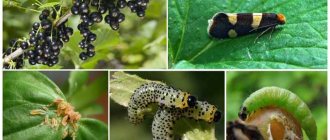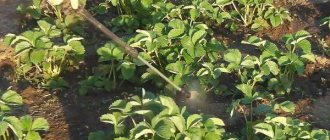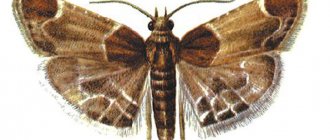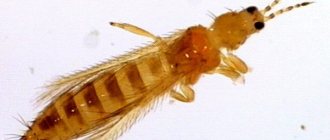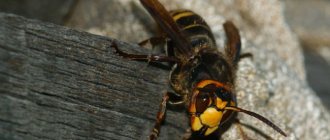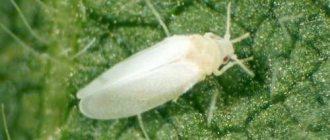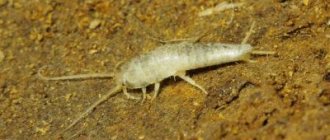What causes houseplant diseases
Violations of the conditions for proper maintenance of indoor plants and flowers, as a rule, lead to their weakening and disease. Diseases of indoor plants are caused mainly by such factors as: excess or lack of humidity, light, heat, nutrients and the acidity of the substrate. Very often, a wide variety of reasons can cause diseases in plants. Let's look at all the diseases of indoor plants and find out what causes the diseases.
When growing indoor plants and flowers, situations often arise when we do not know the causes of diseases of indoor plants. Quite often, hobbyists and flower growers encounter problems that are not easy to solve, but are vitally important.
So, for example, your indoor plant grows for a long time without problems, it pleases the eye and soul, it seems to have enough love, warmth, light and moisture. But suddenly the plant’s leaves begin to turn yellow and curl...
What to do? What to do and how to help your green friend? In this article I will try to help everyone find answers to these difficult questions and tell you about diseases of indoor plants, the causes of their occurrence, as well as treatment and solutions.
Provoking factors
There are a number of factors that cause plants to become infected with various infections:
- Incorrect temperature. If the room where the potted plants are kept is hot or cold, this can cause the foliage to curl.
- Problems with lighting. Lack of light causes thinning of shoots, drying of leaves and a number of problems with the development of peduncles.
- Insufficient acidity of the substrate. If the soil pH differs from the required one, and key nutrients are missing in its composition, flowers stop growing normally and lose their decorative appearance.
- Failure to comply with the irrigation schedule. Excess moisture causes the development of putrefactive processes, and its deficiency causes yellowing of the foliage.
When choosing chemicals for disease control, be aware that they may pose a hazard to people and pets.
Therefore, all work is carried out in compliance with safety rules and optimal dosage.
Diseases of indoor plants. The illustration for the article is used under the standard license ©delniesoveti.ru
Plant diseases and their treatment photo
We will get acquainted with the probable factors that are the causes of plant diseases. And, of course, my dear indoor plant lovers, I will tell you how to fix these problems.
The lower and older leaves of the plant turn yellow
Cause. In winter, this is insufficient lighting or high room temperature. In summer there is a lack of fertilizers and microelements or moisture.
Solution to the problem. In the summer, you need to water the plant as the substrate dries (not allowing it to dry out), and also periodically apply fertilizer (once every 10-14 days).
In winter, place the plant as close as possible to the light source or provide additional illumination with special or fluorescent lamps.
You can reduce the temperature in the apartment by increasing evaporation (this method is not suitable for all plants) by placing the pot on a tray with expanded clay filled with water.
The edges of the leaves turn yellow
Cause. Potassium deficiency, chlorine or tobacco smoke poisoning.
Solution. Water your indoor plants with settled water (not from the tap).
Before each watering, it is necessary to allow the chlorine to evaporate (24 hours). Potassium deficiency can be easily replenished by feeding containing potassium microelements. I’ll tell you a secret that not all indoor plants like tobacco smoke, and therefore, if people smoke indoors, then for such conditions it is worth choosing plants that are more resistant to tobacco smoke.
The ends of the leaves turn yellow
Cause. Dry indoor air. Alkalinization of the soil. Proximity to a TV or computer.
Solution. In order to eliminate the problem of alkalization of the substrate, you need to remove the top layer of soil (1 cm) and then water it with settled water without chlorine. When the air is dry, the plant is often sprayed with settled boiled water; you can also place containers of water in the room.
The houseplant is soft and lethargic (loss of turgor)
Cause. Lack of watering. Failure to comply with temperature conditions. Lack of microelements (copper, potassium, magnesium). Root disease due to waterlogging of the substrate. As a rule, waterlogging of the substrate occurs in winter and is dangerous for any plant.
Corrective measures. Remove the plant from the pot and carefully examine all the roots. If the root system is dark in color and the roots are soft, then the plant cannot be saved.
If only part of the roots are damaged, all darkened roots should be cut off, as well as leaves and stems with traces of rot (it is recommended to sprinkle the cut areas with crushed coal).
It is necessary to keep the plant without soil for a couple of days, drying it out a little. Then you should plant the plant in a pot, replacing the old substrate with a fresh one. The lack of microelements is compensated by fertilizing with the necessary fertilizers.
Buds falling off or buds not opening
Cause. Lack of lighting or lack of phosphorus due to overdosage of nitrogen fertilizers, sharp temperature fluctuations (ventilation), dry substrate, low air humidity.
Solution. In order to increase air humidity, you should place containers of water next to the plant and spray indoor flowers more often.
Know! Indoor plants during their growth and flowering period must be watered frequently and abundantly, immediately after the soil dries out. If there is insufficient light, the plant should be placed closer to the light source or illuminated with lamps. Any plants preparing to flower must be fed with phosphorus fertilizers, in combination with potassium fertilizers.
Flowering is delayed
The reason is a lack of phosphorus.
Solution. We apply phosphorus fertilizers, it is recommended to add potassium.
Thin and pale shoots or leaves become smaller
Cause. Lack of nitrogen for the plant.
Solution. Fertilize with nitrogen fertilizers.
Buds are not formed or there are very few of them
Cause. The conditions of care during the resting period of the plant were not observed. Unfavorable relationship between temperature, lighting and feeding.
Solution. It is recommended to carefully read special literature about indoor plants and the conditions under which they are kept.
Houseplants are wilting
Cause. Lack of moisture or nutrition.
Solution. Water thoroughly immediately after the substrate dries. Feed indoor flowers with phosphorus fertilizers.
No. 10. Leaves curl and wrinkle, interveinal chlorosis.
Cause. Low temperature. Old leaves – deficiency of phosphorus, potassium, magnesium. Plants with young leaves lack molybdenum, manganese, copper, and boron.
Now you can not only determine the causes of plant diseases, but also help your favorite indoor flowers yourself.
The main types of pests on indoor plants and measures to combat them
In order to effectively deal with unwanted guests, you need to know them by sight. Let's look at the main insect pests of indoor plants:
The mealybug or hairy louse is one of the most dangerous and common insects that attacks home flowers. It is distinguished by a wide variety of species: seaside, citrus, cactus, bristly, grape, root. These are quite large (up to 5 mm) insects, the body of which is covered with a powdery powdery coating of white or cream shades. They are quite easy to notice: as a rule, pests gather in colonies on leaves and shoots, leaving behind honeydew (honeydew), similar to lumps of cotton wool.
Mealybugs feed on plant sap and secrete a sweet liquid. A flower attacked by a parasite gradually fades, its leaves turn yellow and fall off, growth and development stops. In addition, honeydew, a waste product of insects, provokes the occurrence of sooty fungus, a dangerous infectious disease.
Root bugs are even more dangerous. While its counterparts are easily found on leaves and stems, this type of hairy louse lives underground, on the roots. The plant, at first glance, is withering for no reason, and its bewildered owner is trying to take some measures to save it by increasing watering or feeding. And only the most experienced flower growers realize that they take the flower out of the pot and find there, as if sprinkled with flour, a colony of insects.
This pest can perhaps be called an omnivore. No house plant is immune from attack. Orchids, ficus, violets, asparagus and even prickly cacti can be attacked by hairy louse. Moreover, if indoor flowers are close to each other, the insect can easily move to another crop and find a new source of food. That is why it is necessary to fight mealybugs immediately, without delaying for a minute, especially since it is much easier to remove single parasites than numerous families.
Folk remedies:
- Manually collecting insects and washing the plant in the shower.
- Treatment of leaves and shoots with a soap solution (1 tsp of crushed solid soap per 1 liter of water or 15 ml of liquid soap per 1 liter of water).
- Treating leaves and shoots with alcohol or alcohol tincture (you need to wipe the flower with a piece of cotton wool soaked in alcohol). Use with caution, after first trying it on one leaf, and only on non-hairy plants!
- Root scale insects: complete replacement of the soil, washing the roots in water at a temperature of about 50°C
Chemicals: “Aktara”, “Aktellik”, “Tanrek”, “Confidor”, “Karbofos”.
Scale insects are a common and quite dangerous pest, especially since novice gardeners often do not understand that they are dealing with parasites, mistaking insects for growths on the trunk and shoots. A dense chitinous shell, the color of which varies from light, cream, to dark brown, helps scale insects camouflage. The size of adult individuals can reach 4 mm. A large number of species of scale insects are known: orange, orange, olive, cactus, palm, ivy, euonymus, which, as the names suggest, prefer to settle on certain plants.
The false scale insect is a close relative of the parasite, distinguished by the absence of a protective shell, but a representative of the order Hemiptera, no less dangerous for plants.
The damage caused to the plant by scale insects and false scale insects is enormous: with the help of a large mouth, insects stick to leaves or shoots, extracting all the nutrients from them, and not only adult individuals are harmed, but also young larvae. The plant cannot regain its strength, turns yellow and withers, and in especially advanced cases dies. As in the case of mealybugs, a fungus grows on micro-wounds formed from insect bites, which further harms the flower.
Perhaps not a single domestic plant can resist the invasion of an aggressor, and the insect often settles not only on leaves and stems, but also on exotic fruits (lemon, calamondin, kumquat). The fight against the pest cannot be put off; measures should be taken immediately to save the green pet.
Folk remedies:
- Careful manual collection of insects, cleaning all parts of plants with a toothbrush.
- Washing the flower under a hot (about 50°C) shower.
- Meticulous treatment of all above-ground parts of the plant with a soap solution.
Chemicals: “Aktara”, “Konfidor”, “Iskra Zolotaya”, “Aktellik”, “Inta-vir”.
Spider mite , unlike previous species, is a very small insect, the maximum size of which is 1 mm. Mites are often invisible to the naked eye, but they are revealed by the silvery web that appears on the leaves, shoots and other parts of the plant, and by light puncture dots on the leaves. There are plenty of types of spider mites that can settle on a houseplant: common, red, Pacific, however, they are almost indistinguishable from each other.
Despite its small size, spider mites, according to some gardeners, are one of the most dangerous parasites that live on our green pets. Firstly, the aggressor quickly spreads, moving on scraps of cobwebs picked up by air currents, and, secondly, it causes irreparable harm to the plant. After a short period of time, the infected plant is completely covered with a sticky web, and the invaders sitting on it suck out all the useful substances from the leaves and young shoots. The leaves turn yellow and wither, fungal infections appear and, ultimately, the flower dies.
The saddest thing is that once a mite has fallen on a plant, it is almost impossible to remove it completely; some part of the population will remain in the soil and appear as soon as the green pet weakens.
Some indoor species with succulent leaves are especially susceptible to mites, for example, all indoor citrus fruits, mini-roses in pots, and ficus. However, any domestic crop can become infected, regardless of species. Spider mites should be dealt with immediately, at the first sign of danger, this is the only way to save a diseased plant from death.
Folk remedies:
- Removing the most infected leaves.
- Spraying the plant with infusions of basil, hogweed, creeping tenacious, pyrethrum or Persian chamomile.
- Treatment of the above-ground green part with Fairy's solution. Dishwashing detergent is mixed with a small amount of water and whipped into a thick foam, which must be applied to the leaves. After 30 minutes, the solution can be washed off. Before processing, cover the soil with a piece of polyethylene.
- Spray the leaves with a solution of tea tree essential oil.
Chemical preparations: “Aktellik”, “Fitoverm”, “Aktofit”, “Apollo”.
Thrips , along with mealybugs, scale insects and spider mites, top the list of the most common parasites of houseplants. Such popularity is not surprising; they can be seen everywhere: in the forest, in the meadow, they even live on vegetables and berries in supermarkets. Moving from plant to plant, thrips actively migrate, devouring all the greenery in their path.
This insect with an oblong body and elongated abdomen can reach 3 mm, and its color varies from light yellow to black. An amazing fact: some larvae of these insects are born already pregnant, and it is not at all necessary for them to mate to reproduce their own kind. And adult winged individuals are excellent at flying. Thus, the pest population can grow endlessly, capturing more and more new territories.
The favorite food of thrips is flower pollen, however, in the absence of it, the parasite will gladly feast on tender leaves and young shoots, leaving small yellowish puncture points and black specks of excrement on the surface. The plant quickly becomes covered with a “rash,” withers, withers, and, if no measures are taken, eventually dies. However, thrips can be called gourmets; they prefer beautifully flowering representatives of the kingdom of Flora: indoor roses, violets, geraniums, streptocarpus, hibiscus. But plants with thick, dense leaves are less susceptible to insect attack.
Fighting thrips is a difficult task, but not hopeless. When starting an attack on parasites, you should remember that many thrips live not only on the surface green part of the plant, but also underground. That is why it is important to treat both the leaves, shoots and flowers, and the soil.
Folk remedies:
- Removing flowers and buds, especially many insects accumulate in them.
- Treating the plant with zoo shampoo against fleas and ticks. There is nothing exotic in this method, because... preparations for animals, as a rule, contain permethrin, a substance that actively affects various parasites. The shampoo must be dissolved in a small amount of water, whipped into a dense foam and applied to the leaves and stems. After 30-40 minutes, the solution should be thoroughly rinsed off. This technique also helps fight spider mites.
Chemicals: “Fitoverm”, “Vermitek”, “Aktara”, “Confidor”, “Inta-vir”, “Tanrek”.
Aphids on house plants are not very common. The large (up to 2 mm) greenish insect is clearly visible even to the naked eye. The main part of the colony is wingless individuals with a thick translucent abdomen and thin, long legs and antennae. However, there are also flying specimens, whose main task is to mate and capture neighboring territories. Most often, greenhouse, peach or nymphal aphids damage indoor flowers.
These parasites, like other pests, feed on plant sap, piercing green shoots and leaves with a sharp proboscis. Light spots of dead tissue form at the puncture site. In addition, during the process of life, the aphid secretes a special secretion, honeydew, which clogs the stomata and glues young leaves and buds together. Another side effect is the appearance of ants that feed on the sweet honeydew.
Aphids are quite easy to detect, so experienced gardeners take the necessary measures in a timely manner, without waiting for the colony to increase. However, not everyone knows that parasite larvae can be found not only on the surface, but also underground, so insects must be combated systematically.
Folk remedies:
- First of all, the aphids must be washed off with a shower. It does not adhere well to the plant and is easily washed away with streams of water.
- A solution of liquid green or laundry soap (20 grams of green soap per 1 liter of water, 1 tsp of crushed laundry soap per 1 liter of water).
- Aphids are repelled by strong-smelling plants, such as geraniums, standing next to the affected specimen.
- Spraying with citrus infusion (4 tbsp zest per 1 liter of water)
Chemicals: “Tanrek”, “Iskra Zolotaya”, “Aktellik”, “Aktara”, “Konfidor”
Sciarids or fungus gnats are, at first glance, ordinary midges, small (up to 40 mm) black flying insects. They are more likely to annoy a person, flying randomly around the apartment. However, not all so simple. Indeed, adult individuals do not harm the plant, but their larvae living in the soil feed on tender roots, undermining the health of the green pet. Actively mating, flies lay future offspring in moist, warm soil, which is an excellent environment for the development of worm larvae. Most often, in the central zone of our country you can find three varieties of winged pests: brasidia, sciara, licoriella.
The fight against them is complicated by the fact that the worms devouring the roots are not visible on the soil surface, and the midges flying around the bowls with the plant, in the opinion of inexperienced owners of home flowers, do not pose a threat. However, a competent gardener, only seeing black flies, immediately understands that the plant is being attacked by sciarids. To make sure that a fungus gnat has appeared on your green pet, you need to remove the upper part of the substrate - the larvae are located shallowly.
To completely get rid of parasites, you should destroy not only insects living in the ground, but also winged adults. If this rule is ignored, a new population of worm larvae will soon appear in the ground.
Folk remedies:
- The best environment for the development of sciarids is moist, acidic and stagnant soil. The use of food waste (residues of tea leaves, shells, potato peelings) as plant nutrition should be avoided.
- Drying the top layer of the substrate will help destroy the clutch of eggs.
Chemicals: “Aktara”, “Inta-vir”, “Mukhoed”. To combat adult insects, sprays against flying insects should be used: “Neo-dichlorvos”, “Raptor”, etc.
Whitefly - this beautiful name refers to a dangerous and very unpleasant insect that harms green spaces. The greenhouse whitefly, a small (up to 3 mm) yellowish flying moth, is especially dangerous for indoor crops. Its body and wings are covered with a white powdery coating, and, in general, the insect resembles a moth.
Damage is caused by both larvae and adults. The insect feeds on the sap of the plant, piercing the leaf with a sharp proboscis, and secretes sticky honeydew. The weakened flower withers, dries up, chlorosis develops on the leaves, and honeydew clogs the pores. Leaves and young shoots, unable to withstand the attack, gradually die off. The result is obvious - insatiable aggressors destroy the plant completely.
Many indoor crops are susceptible to pest attack: hibiscus, fuchsia, gardenia, chlorophytum, dracaena. But geranium suffers especially badly from whiteflies; the flower cannot be saved even by a strong smell that repels all other insects.
The whitefly is very tenacious and often even a single treatment with insecticides does not help. When dealing with it, you need to be patient and, if necessary, repeat the procedure again, changing the active substance.
Folk remedies:
- Before starting treatment, the plant should be washed in the shower. Some insects will be destroyed under jets of water.
- Fumigators against mosquitoes. They cope well with adult flying individuals.
- Green soap solution (see above for concentration)
- Sprinkling the top layer of soil in the pot with ash.
- Fly tape or sticky traps.
Chemicals: “Aktara”, “Golden Spark”, “Prestige”, “Commander”, “Aktellik”.
Other pests (poduras, centipedes, slugs, snails, nematodes) on indoor plants are much less common than those listed above. They need to be dealt with in the same way, using effective folk remedies or systemic insecticides.
Diseases of indoor plants caused by improper care
Diseases of plants living in the house force many amateur gardeners to take a different look at their green friends.
Our favorite indoor flowers and plants can get sick, and since they do not have special doctors, we need to know the main pests and diseases that affect indoor flowers.
Plants get sick not only due to parasites and infections, but there are plant diseases in the plant world that are caused by improper care.
Top dressing
Diseases of indoor plants caused by excess or lack of nutrients, watering, lighting, and mechanical damage to the vegetative parts of plants are called non-parasitic diseases. Such diseases cannot be transmitted from one plant to another and are easily eliminated if the necessary growing conditions are provided.
Air humidity
Plant diseases often occur that are associated with improper air humidity. If indoor air humidity is low, plant leaves dry out and fall off. Flowers, flower buds, tips and edges of leaves become brown and dry. At high air humidity, suberization of stems and leaves may occur.
Watering
Plant diseases occur due to improper watering of flowers. Excess moisture leads to acidification of the substrate and, as a consequence, disruption of the normal functioning of plants.
Difficulty in root breathing occurs, the roots begin to rot, poorly absorb nutrients, and this affects the rest of the plant’s organs. The leaves of the flowers acquire an unusual color, spots appear on them, and the stems at the base begin to rot.
Plant diseases associated with improper watering affect individual flowers differently. Thus, anthurium leaves have bulges (leaf warts) of a light gray-green color.
Begonia, when the substrate is excessively moistened, drops all its buds, suberized spots appear on the leaves of sansevieria, and leaves fall off in poinsettias and azaleas. Moisture deficiency can also lead to stunted growth and drying out of the plant's top.
Lighting
Plant diseases that occur due to improper lighting are widespread. With a lack of light, a houseplant begins to form incorrectly, its leaves become lighter, fall off, and its shoots become elongated.
In case of excessive lighting, the leaves of the plant turn pale, wither and dry out, dry leaf tips or dry brown spots are formed.
In Kalanchoe and begonias, when the light is too bright, and as a result of elevated temperatures, the leaves turn red, and in cacti the stems turn red. Saintpaulia leaves turn yellow and take on a marbled color.
Temperature
Plant diseases associated with improper temperatures also occur. A fairly sharp drop in temperature causes plants to drop and die leaves, and sometimes can lead to death.
In a plant that is hot, the leaves located in the lower part of the flower begin to wither and fall off, and the edges of the remaining leaves darken. At elevated temperatures, the buds of azaleas fall off, and the process of flower appearance in freesia slows down. Only succulents thrive in sudden temperature changes.
Viral diseases
When infected with viral diseases, plants look as if they have been ineptly or poorly cared for. They wither, grow slowly, and lose leaves after first deforming them. As a rule, diseases last a long time, the plants resist with all their might, the owners are scratching their heads over the question of what they are doing wrong, and thrips, whiteflies, and all kinds of aphids that carry viruses are to blame for everything (most often).
In the early stages of the disease, you can try to fight it by removing the affected parts of the plants; good care, care and love work wonders. It is necessary to do a strong pruning, treating all sections with activated carbon. But an advanced disease will kill the plant; there are no drugs that can cure it. Most often, flowering exotics, primrose, begonia, and bougainvillea suffer from viruses. Tools, dishes, place - everything that the virus-infected flower came into contact with must be disinfected in order to stop the spread of the infection and protect the rest of the flowers. The affected flower must be quarantined.
Mosaic disease
With this disease, the chloroplast disintegrates in the leaf cells, which cannot but affect the color. Discolored yellow or very light spots appear on the leaves; they collect along the veins, then spread throughout the entire leaf blade.
Leaf curl
Currants often suffer from curling; in the garden you can see how small areas appear on its leaves, as if swollen. Bulges appear on the leaves, they wrinkle and curl. Pests can infect indoor plants with this virus; they have a very similar effect of leaf deformation.
Jaundice
In the early stages of the disease, jaundice is confused with chlorosis. The leaves lose their rich green color, turn yellow, wither, and droop lifelessly.
Then brown spots begin to appear on them - this is a manifestation of tissue necrosis. Stems may break under the weight of branches and leaves because excess starch accumulates in them. The plant finally loses its decorative effect, turns into a sluggish, broken one; if it manages to bloom, the petals will be colorless.
Diseases of indoor plants photos and how to deal with them
- yellowing of old leaves - lack of macroelements and nitrogen; in the autumn-winter period there is a clear lack of light; too high air temperature (especially at night);
- yellowing of the tips of the leaves - excess calcium in the substrate; dry soil;
- yellow - brown leaves - excess calcium and chlorine in the water for irrigation (especially for azaleas);
- yellowing of the entire plant - chronic overmoistening or severe drying out of the soil; heavy substrate; dense earthen lump (poor air permeability); excessive dryness of indoor air;
- sagging leaves, loss of turgor, shedding of green leaves - watering with too cold water; insufficient watering; high concentration of salts in water for irrigation; violation of temperature conditions for keeping flowers (especially in winter); copper deficiency; for heat-loving plants, keeping them in a place that is too cold;
- leaf curling, wrinkling, interveinal chlorosis - sudden hypothermia of plants; old leaves – lack of potassium, magnesium, zinc; young leaves - lack of manganese, boron, iron;
- curling of leaves along the veins, deformation - damage to young leaves by scale insects, aphids, thrips;
- the appearance of light spots of different shapes and sizes on the leaves - burn of the leaves when exposed to sunlight; in summer: drops of water on a leaf; in winter from damp cold air;
- brown, oily or gray-white spots on the leaves - leaf nematodes, fungal and bacterial diseases;
- dark green leaf spotting is an excess of nitrogen or lack of lighting; if there is a streaked mosaic or mottling on the leaf, then this is a viral infection;
- whitish, pale green, yellow color of leaves with green color of veins - lack of copper, sulfur, iron;
- brown, partially dry spots on the leaves, glassy discharge on the leaves – air humidity is too high; constant overmoistening of the substrate; stagnant air; low temperature or lack of light; fungal disease;
- small punctures or spots on the leaves - pests (mites, thrips, aphids) pierce the leaves in search of plant cell sap;
- holes on leaves or edges of leaves eaten away - beetles, slugs, caterpillars; a fungal disease in which dried areas of the leaf plate may fall out;
- buds are not formed or there are very few of them - violation of the conditions of detention during the dormant period; unfavorable ratio of lighting and temperature; insufficient air humidity; excess nitrogen;
- sudden falling of leaves - a sharp and significant change in temperature; drying out of the earthen coma; fungal disease - verticillium wilt (wild); bacterial wilt;
- falling buds - sudden temperature fluctuations (during ventilation); indoor air is too dry; drying out of the substrate; lack of light; unbalanced feeding; excess nitrogen;
- leaves turn yellow and fall off - the watering regime is disrupted; room temperature is too high in low light conditions; drafts;
- flowers fade - drying out of the earthen coma; general fasting; excess nitrogen;
- short peduncles – incorrect feeding regime; land inconsistency; general fasting; violation of the irrigation regime (excess or lack of moisture); strong temperature fluctuations; violation of conditions of detention during the rest period; excess heat during bud growth;
- powdery white coating on the leaves - a coating on the upper part of the leaf - powdery mildew, and a barely noticeable coating on the lower part - downy mildew.
List of diseases of indoor plants and recommendations for combating them
Powdery mildew
A typical symptom is the formation of a white powdery coating, which contributes to the development of brown spots. Leaves, petioles, and peduncles are affected. They turn brown and fall off, and the buds and flowers also fall off. Control measures: removal of diseased leaves and shoots; spraying plants with a solution of colloidal sulfur (1%) with green soap (1%) until the first dripping drops appear (the best results are obtained by treatment in sunny weather at temperatures above 20 degrees C with repeated treatment after 10-12 days); spraying plants with solutions of topsin - M, benlate, foundationazol at a concentration of 0.2% (repeated treatments - after 10-12 days).
Gray rot
Begonias of the Rex group are severely affected. Dry brown spots appear on the affected leaves at low air humidity. With high humidity, a gray coating forms on the stains. Control measures: spraying with solutions of topsin - M (0.1%), benlate, foundationol (0.2%), copper - soap solution (0.2% copper sulfate with 2% green soap) with re-treatment after 10-12 days .
Brown spot
Round spots appear on the leaves, first pale olive, then dark brown. In areas of damage, leaf tissue falls out. Control measures: see Gray rot.
Late blight
Usually occurs in rooms with high air humidity. Oily spots appear on the leaves and stems, on the lower part of which a whitish-silver coating forms, almost invisible to the eye. Control measures: watering the soil with zineb (0.4%). Next - see Gray rot.
Rhizoctoniosis
The stems are mainly affected, their lower parts become thinner and dry out. Small black dots appear on the affected stems. Control measures: see Gray rot.
Fusarium
The infection penetrates through the roots and affects the vascular system of plants. The affected roots die, causing the plants to gradually wither. Fusarium is observed when the soil is waterlogged and the relative air humidity is high. Control measures: watering plants at the roots with foundationol (0.1%); spraying the above-ground mass with topsin - M (0.1%).
Anthracnose
Brownish spots appear on the leaves, and if the infection is severe, the leaves die. Control measures: spraying plants with topsin - M (0.1%) or foundationol (0.24%).
Verticillium
Sick plants wither and dry out. On cross sections of the stems of affected plants, browning of the conducting vessels is noticeable. Control measures: diseased plants are discarded and burned; in the initial stages of the disease, spraying with one of the drugs is used: benlate, foundationazole, topsin - M at a concentration of 0.2%.
Sooty fungus
The leaves become covered with a black sooty coating, assimilation stops, and they fall off. Control measures: removing sooty deposits from the leaves with a 2% solution of green soap, followed by treatment with a copper soap solution (0.2% copper sulfate with 2% green soap).
Septoria
Dark brown spots with a yellowish border appear on the leaves (usually on azaleas). Gradually they increase and cover the entire leaf blade. Leaves fall. Control measures: see Anthracnose.
Exobasidiosis
Affects azaleas. The disease manifests itself in gall-shaped thickening of leaves and shoot tips, which are covered with a powdery coating. Over time, the leaves turn yellow and fall off. Flowers are also affected. Control measures: destruction of diseased plants along with the soil on which they grew
Bacterial cancer
Tumors (growths) form on the roots, root collar, and sometimes on the stems. With the strong development of cancerous tumors, plants grow poorly, lag behind in development and die. Control measures: see Exobasidiosis.
Oil spot
Gradually darkening oily spots appear on the upper side of the leaves. On the underside, the spots are difficult to see and the leaf appears light. Over time, diseased leaves turn yellow, stems and leaf petioles turn black. The plant withers and dies. Oil spotting can also be caused by nematodes. In this case, the disease progresses faster. Control measures: see Exobasidiosis.
Bacteriosis
Bacteriosis is a disease caused by bacteria. This disease can now be found quite rarely, but it is better to know in advance what the disease is.
The disease occurs not only on garden and garden crops, but also on decorative indoor plants. Enormous damage, and quite often, such diseases occur in bulbous plants. At the very beginning of infection, symptoms on different crops usually appear the same.
Plant diseases occur with wilting or spotting and rot appear on the leaves, and the veins of the leaves may also turn black.
Bacterial spot often affects indoor plants located in damp and warm areas. Bacterial wilt is accompanied by darkening of the blood vessels of young plants. If such a stem is cut, we will see black stripes on the inner walls, from which brown or gray mucus will be released.
Bacteria that cause diseases enter through stomata (natural openings), which are located in the lower part of the leaves, through wounds or any mechanical damage. The causative agents are bacteria that can survive for a long time in the soil and plant remains. Such bacteria begin their viability under two factors favorable to them, high temperature and humidity.
Dense plantings and just droplets of moisture can increase the number of infected plants. Under sufficiently favorable conditions for the development of bacteria, six to eight days usually pass from the moment of infection to the appearance of the first visible symptoms.
A preventive method can be an increased dose of potassium fertilizers, which increase the resistance of plants to the disease bacteriosis. What to do if you notice the first signs of an unhealthy plant:
- For bacterial wilt, it is recommended to use copper oxychloride (a ratio of forty grams per ten liters of water) or a one percent Bordeaux mixture. It is necessary to treat a painful plant after one to two weeks.
- To combat bacterial spotting, the plant is sprayed with the solution recommended in point 1. in the same proportion and with the same frequency.
I hope that with excellent care for indoor flowers, plant bacteriosis will be known to you only theoretically.
Gommoz
Gommosis disease occurs in most cases in citrus fruits. The disease occurs when there is an excess of nitrogenous fertilizers, when the plant is planted deep in the substrate, due to excessive watering and heavy soil composition.
When gommosis occurs in a plant, brownish-red longitudinal spots appear on the bark of the trunk. Subsequently, the bark dies and a yellowish, sticky liquid called gum begins to flow out from under it, through cracks, and dries in the air.
The disease can occur without fluid leaking out; in this case, the stem bark becomes dry and does not lag behind the trunk at all, but cracks still form. The leaves of the plant become greenish-yellow, then completely turn yellow and fall off. The fruits of the plant are small.
Chlorosis
Leaf chlorosis is a disease that occurs when there is a lack of zinc, manganese and iron in the substrate. Or due to a disrupted absorption process of these elements, mainly in soils with excessive liming.
When the disease is chlorosis, the lower leaves of plants turn yellow and die as a result (as a rule, only the leaf veins remain green). There is a slow development of all other plant organs: buds, leaves, stems, and root system.
In most cases, this plant disease is aggravated by poor drainage, high substrate moisture and a high content of nitrates in the soil mixture.
Bacterial lesions
In addition to viruses, indoor plants are vulnerable to bacterial infections. Among them:
- Putrefactive formations. The problem is dangerous for those species that have fleshy shoots and dense foliage. Among the predisposing factors to the development of rot are excess moisture and excessively high concentrations of nitrogen in the soil. Saintpaulias, cyclamens and sansevierias are subject to rotting.
- Withering. In the early stages, the stems begin to wither, and soon other parts of the plant. In the place of cuts of such specimens there are no brown rings that appear when infected by fungi.
- Spotting. The disease is accompanied by the death of leaves. The spots become pronounced, and not chaotically scattered, as with fungal spots.
- Bacterial cancer. After infection, growths resembling tumors appear on different parts of the plant. First they affect the root system and stems, and then are transferred to other parts.
It is not advisable to use chemical compounds to combat infectious diseases, since they are ineffective. It is better to carry out preventive measures in time, maintain the required soil moisture, and when putrefactive processes develop, reduce the intensity of watering. If the entire plant is affected, it must be disposed of with the substrate and container.
Diseases of indoor plants. The illustration for the article is used under the standard license ©delniesoveti.ru
Root rot
Root rot belongs to a large group of plant diseases. The disease differs from other diseases of indoor plants in that it destroys tissue cells, leading to inevitable rotting of the roots.
In turn, root rot is divided into root and basal varieties, that is, it can affect not only the root system, but also the bases of plants, which is why it is so difficult to determine the source of plant infection.
All diseases of indoor flowers: root rot, late blight, verticillium blight, fusarium blight, etc. are in turn caused by various fungal diseases that appear when the substrate is too wet.
Some diseases infect only herbaceous plants, while others can harm shrubs and even trees.
So, for example, with a disease such as late blight, the causative agent of the plant disease can be in a safe state for many years, but under favorable conditions for infection, the appropriate temperature and air humidity, the pathogen will begin its life activity.
When infected, the roots of flowers and plants usually turn brown and die as a result. After the root system has died, the affected tissues appear on the leaves of plants and flowers. In this way, root rot causes the death of the entire plant.
Control measures. Infected plants require destruction; The substrate from the plant must also be thrown away. The flower pot should be thoroughly washed and disinfected with a forty percent formaldehyde solution.
Attention! If diseases of indoor plants are your pressing problem, then it is worth analyzing all the factors of maintaining and caring for indoor plants at home.
Main development factors
There are four main factors influencing the life of houseplants: light, temperature, moisture, soil.
For each type, the requirements for all these factors differ. Different plants need different amounts of light. In addition, how many hours of daylight there are is of great importance. It is very important to create conditions that meet the requirements of temperature and humidity levels. The soil, in addition to performing the function of feeding basic substances, must also have a level of acidity exactly what each plant requires. Violation of maintenance conditions or the initial creation of incorrect conditions weakens the plants so much that it becomes the main factor in the development of diseases. Many diseases of indoor plants may well develop from a sharp change in temperature, for example, when it drops by 7 - 10 degrees in humid conditions, the flowers are threatened by fungal diseases, because the smallest pathogenic spores can penetrate into the cleanest apartment.
A room is not a fortress; pests sometimes penetrate into it, but they are dangerous in themselves and also carry many diseases. If plants are weakened by poor maintenance, then they are all at risk. Therefore, it is necessary to monitor the level of temperature and humidity, maintain the required acidity and nutritional value of the soil, and provide the flowers with the optimal amount of light. Otherwise, they will show insufficient conditions and care, or get sick.
Pests and diseases - protection and prevention measures
No matter how well you care for your plants and flowers, all your efforts and efforts can be completely in vain if pests and diseases arise.
Occurrence occurs for many reasons, and not all of them can be explained. The most common cause is infection and the transfer of diseases and pests from plant to plant, for example when purchasing a new plant.
The second reason, pests and diseases, can be latent inside the plants themselves.
When conditions are favorable for pests - a dry, warm atmosphere in your home or improper care - and then favorable conditions arise for the development and manifestation of pests and diseases. Although the second reason is more common in cases of plant disease, rather than the occurrence of pests.
How to protect our favorite indoor plants? The most effective method is preventive disinfection. Agree, prevention is always better than cure!
Prevention is carried out by spraying plants and flowers with a fungicide or insecticide diluted in water, once every two to three weeks in the summer months.
Most chemicals are hazardous if used incorrectly. Always choose the safest option. For example, pyrethrum and derris are the safest means.
A small number of pests can be easily removed by hand; mealybugs are removed with a cotton swab moistened with methyl alcohol. The reappearance of red spider mites can be prevented by increasing the humidity in the apartment. If you are forced to use more potent agents, then you must adhere to all the guidelines specified in the instructions.
Rules required when using intexides:
- Always store chemicals and spray materials in a dry and frost-free place;
- keep them away from children, animals and food;
- When preparing the spray material, strictly follow the instructions;
- Always prepare the amount you use at once;
- spray a houseplant only outdoors;
- Spray only in the evening when there are no bees around;
- When finished, thoroughly wash the spray bottle inside and out;
- After completing the preventive spraying procedure, wash thoroughly with warm water and soap.
It’s not for nothing that they say that forewarned is forearmed!
By regularly (once a week) a careful inspection of house plants and flowers and performing preventative summer spraying, you are guaranteed to protect your indoor flowers and plants from all troubles and misfortunes!
PS Unfortunately, I am familiar with such a terrible disease as cirrhosis of the liver, not from literature, but in reality. A very close and dear person died of cirrhosis, the form of the disease was severe, and the treatment did not bring the desired result.


